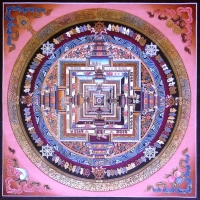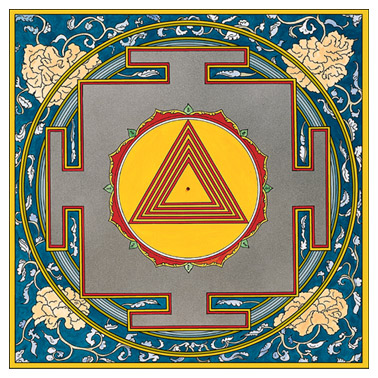
Shambala
Some people say that Shambala
is hidden in a remote part of the Himalayas. Some call this mysterious
kingdom "a house of the immortals" - Gyanganj.
It is identified as Shambala, Shangri-La or Siddhashram,
but this "wondrous land" has many other names too.
This
article published in the Buddhist channel.
In Tibet, the word for a legendary and enlightened kingdom (Shambala)
means a "source of fortune". It is not the "heaven" we see from our
Earth, but a mystical kingdom that guards the most secret spiritual
teachings of the world and of the universe, including the Kala
Chakra tantra, the Wheel of Time,
which is a pillar of the Buddhist
wisdom.
By certain meditation exercises and good perception clever adepts
may succeed in peeping into this realm. Buddhism
connects Shambala with Buddha who allegedly took form of one
of the Kala Chakra gods and delivered his highest teaching to a group
of followers in Southern India. Among these was also Suchandra, who
was the king of the northeastern Indian kingdom and he requested this
teaching from Buddha.
In ancient India and Tibet, there were small kingdoms scattered
around the area. In Tibet, the pre-Buddhist
shamanistic Bön culture was part of the Zhang
Zhung kingdom. It is known that the concept of Shambala
predated Buddhism. The Mongolians
identify it with certain parts of southern Siberia. Ancient Zhang
Zhung texts identify Shambala as a place in the Sutlej
Valley in Himachal Pradesh in northwest India. The Tibetan
Buddhism, which later developed in the region, adopted many aspects
of the above culture including the concept of Shambala. But according
to the present Dalai Lama, "Shambala is not a physical place
to find anywhere on Earth".
Bequests of Shambala are part of the Indian history - that is, they
can be found both in Hinduism and Buddhism in ancient writings. Interesting
is the fact that near the area of Sutlej Valley there is a place called
Kongka La, which is in the disputed China-India border and
the local people report that UFO's can be seen here coming out of
the ground.
Our culture is focused on seeing something first, only then does
follow the believing that things we see do actually exist. The mystical
kingdom of Shambala can only be approached in a reversed direction:
first to believe in its existence, then coming closer to it. If we
have luck, we finally catch a sight of it. Hindus call it Paradesha
or Aryavarsha - that is, a place from which the holy
Vedas came from. Celts in their Arthurian legend
based on a pseudohistorical account speak of a mystical island called
Avalon. Tibetan texts describe Shambala also as a holy Mount
Meru with notes that technology of its inhabitants is very
advanced. In Greek mythology, Shambala is known as Hyperborea.
Regardless of Buddhist lamas and other spiritual people involved
in the topic (their custom is not to publish their most secret knowledge),
a French writer Joseph-Alexandre Saint-Yves (1842-1910), as
one of the first Europeans, presented the concept of Shambala and
consequently of Agartha to the West. He educated himself alone
as an occultist and philosopher. Other important personality was a
Polish scientist Ferdinand Ossendowski (1876-1945), who spent
most of his life in Russia. On his tours around Mongolia he often
spoke with Buddhist monks. He started to be interested in Shambala
soon after he met one lama who fled from Russia at the time of the
Bolshevik revolution and who had a close relationship with the Tibetan
Dalai Lama. Other important person was Nicholas Roerich (1874-1947),
a Russian artist, poet, mystic and writer, who led the expedition
through the Gobi desert and a rumor has it that the expedition
was financed by the Soviet secret service NKVD, which was later renamed
to KGB.
The picture shows the Kala Chakra Yantra.

The Tibetans and tourists sometimes speak about strange phenomena
occurring in the Himalayan region. In the beginning of the 20th century,
an article was published in one Indian newspaper (but there are many
such stories) about a visit of a British mayor who camped in the Himalayas.
He suddenly saw a tall strange man who watched him. The man jumped
out of his hiding place and disappeared, but to the mayor's big surprise
the Tibetans with whom he camped in the mountains were not surprised
in the least - they explained to him, without showing any excitement,
that he saw one of the snowy men who kept guarding the entrances into
the Holy Earth.
Andrej Strelkov, a Russian scientist, has studied Shambala
for quite a log time. He says that the existence of this legendary
kingdom is really described in ancient texts and that its "inhabitants"
are superior to us in their abilities. He says that all attempts to
penetrate the secret of Shambala brought bad luck or failure. For
example, most scientists who studied Shambala tragically died. A German
Orientalist Albert Gruenwedel, who lived in the first half
of the 20th century, went crazy while translating some Shambala texts.
In a state of temporary lunacy he threw himself out of the window
and died. There are more such cases.
Many of those who wanted to study this subject from a "scientific
point" did not have luck. However, if someone asks a question why
this "magical kingdom" kills people, we must take into consideration
the fact that most scientists are only interested in their personal
profit and they do not perceive Shambala as something real.
An interesting finding is that there are unbelievably close similarities
between the Biblical Apocalypse and the Kala Chakra Prophecy,
according to which Rudra Chakrin, the last king of this mystical
kingdom, will impose the Golden Age on our Earth at the end of Kali
Yuga, which is a Hindu term for the period of darkness, which
must end one day. Thus, according to some people, this Shambala King
will be the last incarnation of Lord Vishnu - Kalki,
who is to appear here and bring harmony and justice.
Some say that Shambala prophecy also contains notes about messiahs
of other religions. When these "barbarians"
who only devastate our planet will think that no one can conquer them,
the icy mists of Shambala will appear. Many lamas believe
that this can happen around the year 2012, but it is very difficult
to calculate this, as one must have absolute understanding of Shambala
- its inner wisdom also requires
understanding that it is so secret that only a few things about it
can be revealed.
There are two basic views about Shambala:
1) It is a mystical kingdom that can appear or disappear; which
can be only seen by people with pure heart; it exists in a parallel
universe.
2) It is the capitol of the Agartha network - ancient subterranean
cities joined by tubes where vehicles travel like shuttles in very
high speeds. It may function as a stargate and a time gate.
Roerich, after carrying out his expeditions, said that there were
caves in the Himalayas that go deep into the underground.
There were so many species of life forms in our ancient history
that I can conclude that if only about two per mille of species do
exist now, it is possible that a different humanoid race could evolve
or could even be created long time ago. Thus, on the basis of many
"underground legends" (for example, Osiris in Egypt, snake
or Naga people in Sanatana Dharma), various occult theories emerge
in relation to the fact that our Earth is hollow, or - if not, the
existence of large subsurface cavities in it is probable.
It is known that Uloopi was one of the Arjuna's wives; Mahabharata
writes about this. The "Naga princess" Uloopi conveyed Arjuna to her
netherworld realm. If some people try to go through the Bible word
by word, why Mahabharata should be an exception?
See my new page on most sacred mountains of
Hinduism and Buddhism - Shambala is believed to have existed somewhere
in Kashmir (in Hunza Valley).
Copyright (c) Giorgio Sipos
Back


